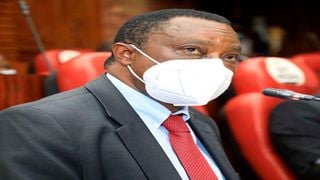
National Treasury Principal Secretary Julius Muia when he appeared before National Assembly’s Departmental Committee on Finance and National Planning on September 29, 2021.
| Jeff Angote | Nation Media GroupBusiness
Premium
Revealed: Treasury diverted billions meant for fuel subsidy
The government used money meant to cushion consumers from high fuel prices to build petroleum infrastructure, Treasury Principal Secretary Julius Muia told lawmakers yesterday.
Mr Muia (pictured above) appeared alongside Kenya Revenue Authority (KRA) Commissioner-General Githii Mburu before the National Assembly’s Finance and Planning Committee to respond to a petition by Matungulu MP Stephen Mule seeking to reduce taxes and levies on fuel.
This happened as two members of the public also petitioned Parliament to amend the Finance Act, 2018 to remove the 8 per cent Value Added Tax (VAT) on fuel.
The PS said the Treasury drew Sh18.1 billion from the Petroleum Development Levy Fund that is meant to help stabilise fuel prices and gave it to the State Department of Infrastructure to pay for upgrades on petroleum facilities.
The transfer was made even as consumers pay Sh18 per litre of petrol and diesel into the Road Maintenance Levy Fund (RMLF), whose proceeds are used to upgrade road transport infrastructure.
That withdrawal virtually depleted the fund, forcing the Ministry of Petroleum, in the latest review, to pass on the full brunt of higher global crude oil prices to consumers, minus the subsidy.
Mr Muia said the Treasury wired Sh1.6 billion from the fund to the Ministry of Petroleum in the 2020/21 financial year to keep fuel prices stable, and Sh2.2 billion to the Ministry of Energy.
He also said the Treasury received Sh25.08 billion into the fund during the last financial year after the rate of the levy was increased to Sh5.40 per litre from Sh0.40.
That was a steep increase from the Sh2.1 billion and Sh2 billion that the fund received in 2018/19 and 2019/20 respectively.
“The case we have is like when you have set aside money for your child’s school fees but then you go ahead and use the money on chapati,” quipped committee chair and Homa Bay MP Gladys Wanga.
“The Ministry of Petroleum is the one that writes to us requesting money from the fund for the subsidy. But this is on the basis that there is enough money in the fund to fulfil the request,” PS Muia told MPs.
“In the financial year 2021/22, a further Sh5 billion was made in August following a request from the ministry because the fund had enough money. The ministry made a further request of Sh5 billion in September and unfortunately the fund did not have that money and therefore the request was not honoured.”
The fund now has only Sh3.6 billion left, he said, and that was inadequate to subsidise fuel this month.
But appearing before the committee earlier, Petroleum PS Andrew Kamau told lawmakers that Treasury had approved the ministry’s request for funds to subsidise fuel but only after the energy regulator had reviewed the prices to be in place until next month.
“The Treasury wrote back to us and approved for us to apply the stabilisation fund. But this was after the prices had already been reviewed, and we are already two weeks into the current cycle. Now, even if we were to apply the subsidy now, what formula would we use to compensate oil marketing companies?” Mr Kamau said.
But the PS said the Petroleum Development Levy Fund Act, 1991 and the Petroleum Development Levy Fund Order of 2020 give the Treasury the powers to draw the funds from the kitty for upgrading petroleum facilities.
“The two laws the PS has cited do not give him any powers to misallocate funds that are derived from the levy. This is like taking money meant to provide food for your children and giving it to your neighbour to buy land,” said Roysambu MP Ndirangu Waihenya, the committee’s vice-chairperson.
“You have told us that the only place you can get money to stabilise fuel prices is the PDLF, yet you are taking money from the fund to build infrastructure, which you can use funds from the Road Maintenance Levy Fund to build. This misallocation of funds really disturbs me,” Ms Wanga added.
The Treasury also disagreed with the Ministry of Petroleum and the Energy and Petroleum Regulatory Authority (Epra) on the amount of money used in the fuel subsidy, leaving consumers in the dark on how much was actually expended on the fuel subsidy.
Mr Muia said the Treasury had disbursed a total of Sh6.6 billion to the ministry for the subsidy, a Sh2 billion difference from the figure provided by the ministry and Epra, which said they had used Sh8.6 billion to compensate oil marketing companies between April and August.
The committee is drafting a bill to guide the setting of fuel prices, and it will be submitted to Parliament on Tuesday.





